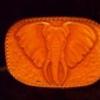
Sharpshooter
Members-
Posts
65 -
Joined
-
Last visited
About Sharpshooter
- Birthday 05/16/1956
Contact Methods
-
Website URL
http://sharpshootersheaths.com/
Profile Information
-
Gender
Male
-
Location
Da' U P of Michigan
-
Interests
I love the outdoors, now I'm in the business of helping other people enjoy the outdoors by supplying them with the best possible sheaths and accessories for their knives.
LW Info
-
Leatherwork Specialty
Commercial Sheathmaker
Recent Profile Visitors
5,028 profile views
Sharpshooter's Achievements

Member (2/4)
-
You can spend a bunch of money on a dedicated press, OR.... Get an Arbor Press from Harbor Freight, it's cheap. My snap dies came from one of the bigger commercial hardware suppliers with a 3/8" stem on them. Drill a 3/8" hole in the base plate of the press and another in the bottom of the arbor with another perpendicular to it for a set screw. I'm not big on mentioning non advertisers on forums, the guys who pay the freight should be deriving the sales benefit, so if they don't have it, shoot me an e-mail and I'll tell you who to contact. There is a knife supply house that sells the press with the holes added in if you don't feel like messing with it for about $40 more. Perfect for snaps, eyelets and if you're cagey, you can order a maker's stamp "PLATE" epoxy it to a block of wood and install a stem for the press. The impressions are always perfect. You'll find yourself using the arbor press for everything.... and it'll [pay for itself in nothing flat. If you need a pic of mine to help visualize it, shoot me an e-mail.
-
A more important question is "What do you intend to do with it?" If you plan to go into business, I don't think the Tippmann will be the way to go. To start with, you set the die on your leather and feed them into the opening in the machine; VERY slow. Real Clicker presses have the head getting out of your way so you set the die on the leather and move the head over the top to click. The Tippmann is air operated, actually it's an air spring under the bottom which inflates to press up against the stationary top, you need a compressor with good capacity to keep up with the machine. Clicker presses have a pressure limit, in the case of the Tippmann machines you're looking at 7 or 15 tons. Dies are essentially designed with an eye toward the pressure of the press, a 7 ton press is really a belch in a wind storm meaning you'll be limited to some very small dies. Even the 15 ton unit is marginal compared to commercial machines. The few times I have worked with a Tippmann I noticed how you seem to sit and wait for the pressure to push the die through the leather, for a few seconds. That doesn't sound like much time until you think about clicking 200 pieces, (that's only 50 four piece sheaths), you are waiting for 400 seconds, that's almost 7 minutes of waiting for the press to do it's job. My clicker press is a 40 ton unit, I hit the buttons and the head makes the cut in the blink of an eye. Now lets talk about price.... the 7 ton unit is $1500, the 15 ton $3000. Tippmanns ad lies about not needing electricity unless they plan on you running the machine with a bicycle pump so add in a decent compressor. You can buy a used clicker press on E-Bay for around $2000 add a couple hundred for a phase converter since most of the commercial presses run on three phase power. When I started in the business, I decided to do it right or not at all. A first class stitcher and clicker press were the core elements and doing it right is something I've never regretted.
-
Got it on the my Landis 3 in 1 The American Skiver is an old timer... The blade isn't as wide and there's nothing at all that looks like a stop. Thanks to your help on the Landis, I think I can SWAG the blade placement to get a baseline. It's completely disassembled and sandblasted, tomorrow a wipedown, blow off and base coat of paint. I'll post pics when it's all done and back in service.
-
Thanks Bruce... You're referring to actual stops for the front (edge) of the blade? I'll have to look at it in the morning to be sure, but I don't recall seeing anything like what I'm imagining. I believe there are screws on either side of the blade to hold it down and a thumbscrew on the back (opposite end of the edge). I have the machine taken completely apart at the moment, going to sandblast the body for a repaint and clean up the mechanicals. The rollers have some play and slop that needs to be taken care of so the machine can give us another eighty years.
-
Hey... I have a new blade for my old American Hand Crank Skiver. It works much like the skiver on the Landis 3-1 and 5-1. I'm resigned to the fact that I have a better chance of stuffing snowballs up a wildcat's butt than I do of finding a manual for the machine; but I KNOW someone here knows how it's supposed to be set-up. There is a depth of cut adjustment as well as angle AND the ability of moving the blade closer of further from the rollers. I'm sure I can stumble into the sweet spot, but the correct procedure will make it easier and faster.
-
Probably a price that you're thinking of would be helpful... Shoot me a number.
-
Timber scribes share that "7" profile but don't have the U shaped end. Th U shaped cutting edge makes it a "Rase Knife" While the gouge mark can be used to mark logs or most commonly barrels it was most often used to e"Rase" marks so the barrel could be reused. Another very common use for Rase knives was to mark the waterline on wooden boats so it could be easily found when the boat is repainted.
-
Making Clicker Dies - And Need Clicker Suggestions
Sharpshooter replied to Prince's topic in How Do I Do That?
We have to be clicking out pieces or we would be out of business in very short order..... A couple of answers... You have to heat treat steel in order to make it a knife or cutter. Soft steel doesn't have the carbides that are formed by heat threat so you can't get it sharp. Steel Rule Dies are much more precise than clicker dies. That might not be important to you if you aren't doing production work that requires precision. My sheaths have eyelet holes and snaps that have to line up.... fussing with 500 snap locations would kill any profitability of a job. The small Tippman clicker might be fine on thin leathers but 5 ounces on up and it has issues. The bigger Tippman might be better but for the price you can get an electro hydraulic press that will be much easier to work with. I get all of my steel rule dies done by AC Steel Rule, they do a terrific job and always provide great service. I have had them do enough dies for me that they understand leather work. -
In need of a new shop toy: a good handheld mini-vacuum
Sharpshooter replied to esantoro's topic in Leatherwork Conversation
I don't know if there are any good ones available.... Everything I've read says that even the best ones suck. -
Every product we make in my shop has MY name on it and I don't feel in any way embarrassed by it. When people compliment the work we do, I put the team in front and tell everyone what a terrific job they do. When things go to hell in a handbasket it's ME that has to deal with it. When business is slow, I'm the one who goes home without a paycheck, the crew get paid. When a run of sheaths is wrong, I decide to not ship it and I eat the loss because it's MY business. I take the risks on a daily basis so your damn right MY name is going on the product. If your carver is worth a damn, he's likely put his mark on the job... The people who do that work for me are told flatly that I expect them to do so. Louis Chevrolet quit building cars a long time ago, around the same time as Henry Ford did. William S. Harley and Arthur Davidson don't build many motorcycles nor does Sōichirō Honda, last time I checked all of them are still dead but there are products sold with their name on them every day. If you like, have the guy from the Billiards Forum come see me personally.... I'm running low on jackass hide.
-
Problem sewing Tandy Skirting leather, Any ideas?
Sharpshooter replied to Vaquero's topic in Sewing Leather
We do a lot of sewing VERY thick stacks of leather. In my most recent job we're sewing through two layers of 10 ounce, two layers of 6 ounce and a .030 thick piece of vulcanized fiber sheet. I doubt that a bit of rawhide is going to be tougher than the vulcanized fiber sheet. We're sewing this on a Toro 3000 with success. Here's what I've learned on this job... I generally use 346 on top and 277 on the bottom with a #25 Needle. The needle isn't big enough for me to use 346 on top you can actually feel the thread binding in the fiber sheet. I stepped down to 277 top and bottom which is a lot better. I also found problems starting to show up with sticking and such as the needle dulls. Like my good friend Steve told me a long time ago.... the first step in diagnosing a sewing problem is "CHANGE THE NEEDLE!" Needles are relatively cheap and while they're tough as nails (pun intended) they're also very fragile. I've seen bent points that acted just like barbs on a fish hook they go in very easy and snag on the way back out. -
Hey... Has anyone here done wet molding on a production scale? I have a job coming up where I need to mold a lot of pieces for a production run... I'm wondering about speed.... Does the leather need to be dry (mostly) before removing it from the mold? How long does it HAVE to be in the mold? I have a pretty good idea HOW to do the molding, I'm just rather concerned with the time invested in each piece. 500 molds doesn't make sense.... 10 or 20 does.
-
I have used both and really don't see much difference between them. Realize that I buy 20+ sides a month so I go through a lot of leather. Ask for their sample sheet and you'll see what they sell. I don't use the "treated" stuff so I can't comment on it other than to assure you that it is available from them. I believe W&C is a bit easier for smaller accounts to deal with as far as smaller minimum quantity requirements.
-
i need help for a knife sheath
Sharpshooter replied to flyingcuda's topic in Gun Holsters, Rifle Slings and Knife Sheathes
That assumes the knife has a guard (protrusion at the front of the handle to stop fingers from going forward on the blade) if so, look again on my site at Construction... it's NOT a tutorial but it shows you all the pieces and how they inter relate... you should be able to figure it out from there.... If not... you know where to ask.



